14+ Crisis Communication Rules
In the high-stakes world of crisis management, understanding and applying Crisis Communication Rules is crucial. This guide offers an in-depth exploration of these rules, providing readers with the essential knowledge to effectively handle crisis situations. Whether it’s a natural disaster, corporate scandal, or public health emergency, the right communication strategy can significantly alter outcomes. We delve into practical examples and expert insights, ensuring you’re equipped with effective communication tools and techniques to manage any crisis confidently.
What are Crisis Communication Rules?
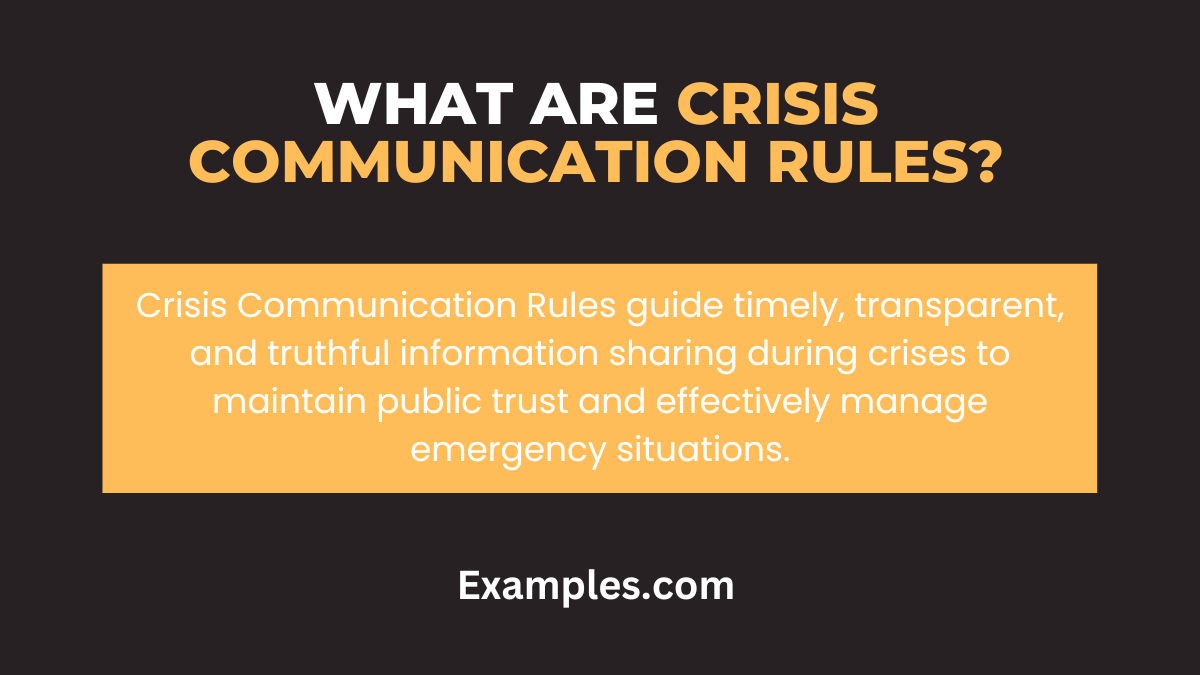
Crisis Communication Rules are a set of guidelines and principles designed to guide organizations and individuals in effectively communicating during crisis situations. These rules encompass strategies for timely, transparent, and truthful information dissemination. They focus on maintaining public trust, minimizing misinformation, and facilitating efficient crisis resolution. Understanding these rules is essential for any crisis management professional, as they dictate how to communicate under pressure, coordinate with different stakeholders, and manage public relations to mitigate the impact of the crisis.
What is the Best Example of Crisis Communication Rules?
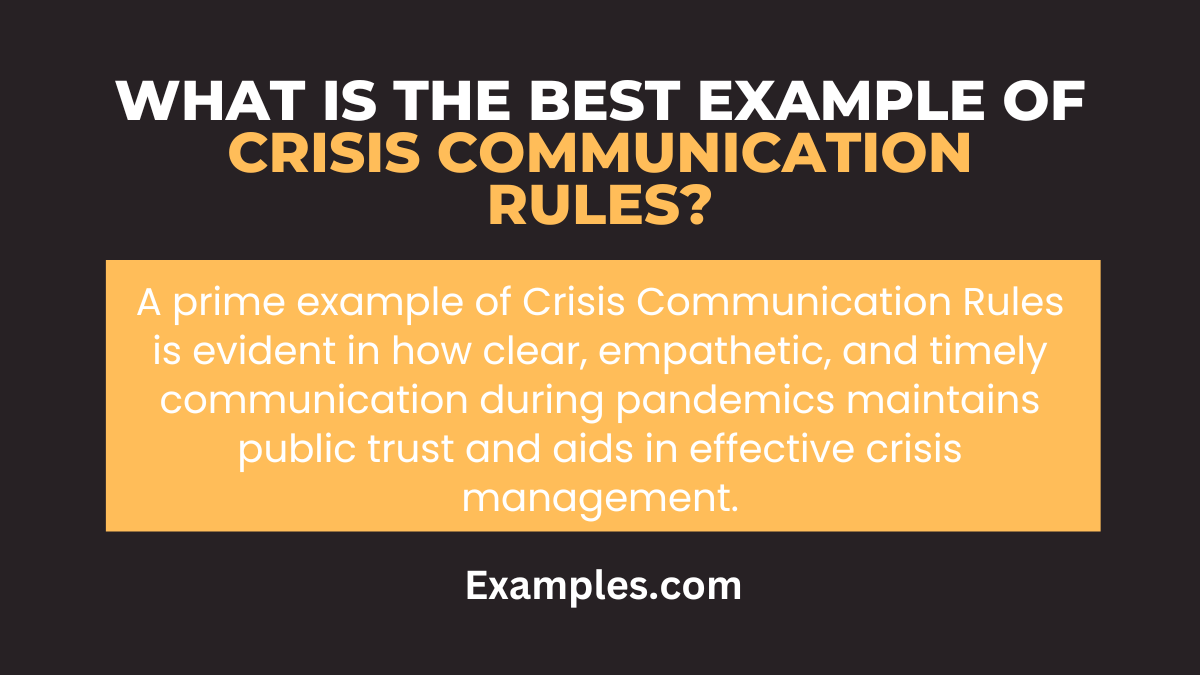
A prime example of Crisis Communication Rules in action is the proactive and transparent communication strategy employed during public health crises, like pandemics. In such scenarios, the rules emphasize the importance of providing accurate, up-to-date information to the public, addressing concerns empathetically, and correcting misinformation swiftly. Key aspects include using clear, understandable language, regularly updating stakeholders, and ensuring that all communications are coordinated across various channels. This approach helps in maintaining public trust and cooperation during critical times.
15 Crisis Communication Rules Examples
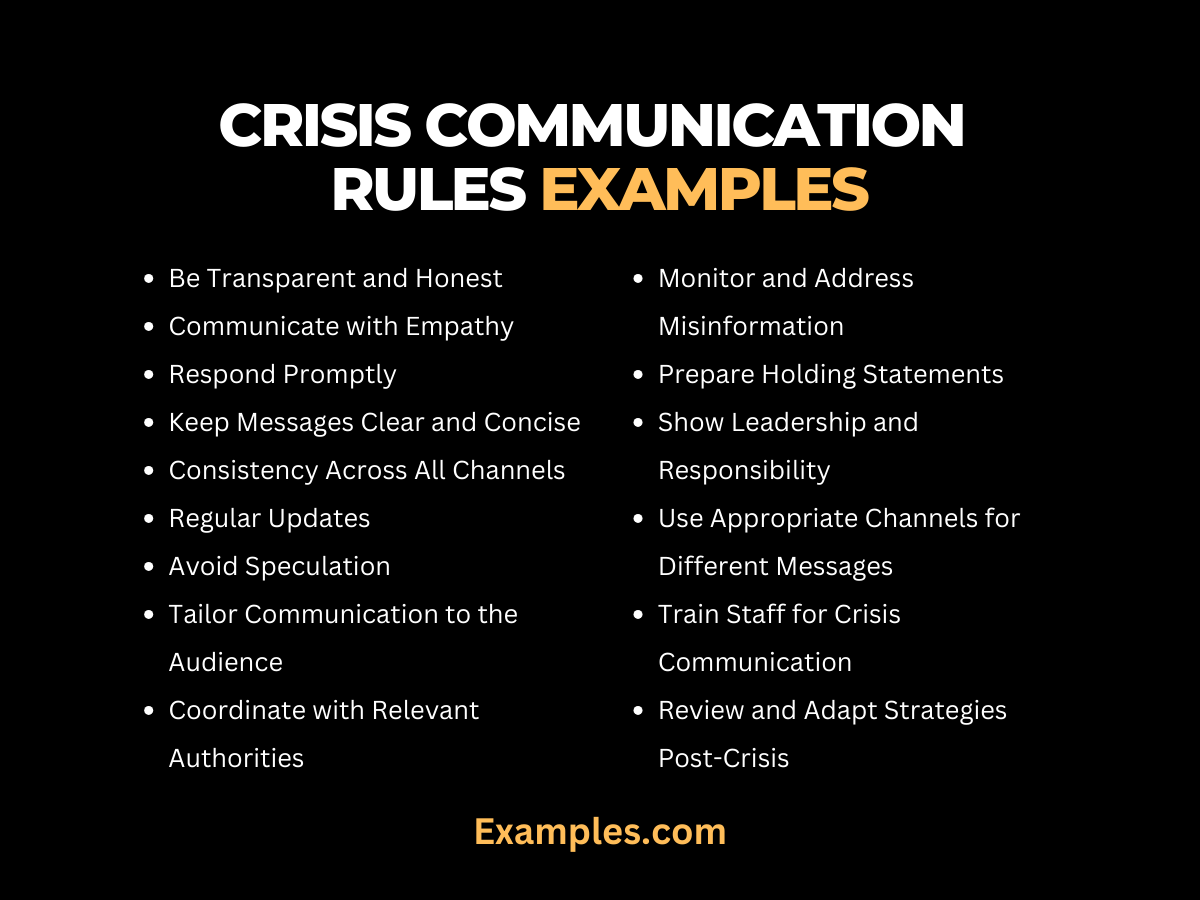
In the realm of crisis management, effective communication is key. This guide outlines 15 Crisis Communication Rules examples, each vital for navigating through turbulent times. These rules blend effective communication strategies with crisis response principles, ensuring clear, accurate, and timely information dissemination. From maintaining transparency to addressing misinformation, these rules are designed to uphold public trust and facilitate efficient crisis resolution. They are crucial for any organization aiming to handle crisis situations adeptly, preserving their reputation and stakeholder relationships.
- Be Transparent and Honest
- Emphasize honesty to maintain trust and credibility.
- Example: “We are committed to sharing all relevant information as it becomes available.”
- Communicate with Empathy
- Show understanding and concern for those affected.
- Example: “We understand your concerns and are here to support you.”
- Respond Promptly
- Quick response prevents misinformation and speculation.
- Example: “We are aware of the situation and are actively working on a solution.”
- Keep Messages Clear and Concise
- Avoid confusion with straightforward communication.
- Example: “For your safety, please follow these clear guidelines…”
- Consistency Across All Channels
- Ensure uniform messaging across all communication platforms.
- Example: “Our statement on the matter remains the same across all our platforms.”
- Regular Updates
- Keep stakeholders informed with ongoing communication.
- Example: “We will continue to provide updates every hour.”
- Avoid Speculation
- Stick to verified facts to maintain credibility.
- Example: “We will share more information once it’s confirmed and verified.”
- Tailor Communication to the Audience
- Modify messaging to suit different stakeholder groups.
- Example: “For our employees, here are the specific steps we’re taking…”
- Coordinate with Relevant Authorities
- Work in tandem with authorities for unified messaging.
- Example: “We are in close coordination with local authorities to address this issue.”
- Prepare Holding Statements
- Have initial responses ready for immediate release.
- Example: “We are currently gathering more information and will share details shortly.”
- Monitor and Address Misinformation
- Actively correct false information.
- Example: “To clarify, the information circulating about X is not accurate. Here are the facts…”
- Show Leadership and Responsibility
- Leaders should be visible and accountable.
- Example: “As CEO, I take full responsibility and am committed to resolving this.”
- Use Appropriate Channels for Different Messages
- Select communication mediums wisely based on the message.
- Example: “For detailed updates, please refer to our official website.”
- Train Staff for Crisis Communication
- Equip team members with crisis communication skills.
- Example: “Our staff has been trained to handle inquiries and provide accurate information.”
- Review and Adapt Strategies Post-Crisis
- Analyze and improve communication strategies after a crisis.
- Example: “We will review our response and make necessary improvements for the future.”
Rules of Crisis Communication Examples for a Company
Effective crisis communication within a company is critical for managing any emergency situation. These rules are designed to ensure companies communicate efficiently, maintaining trust and stability. Covering aspects like internal communication, leadership involvement, and stakeholder engagement, these guidelines help in navigating complex crises. They emphasize the need for clear communication, rapid response, and consistent messaging, vital for preserving a company’s reputation and ensuring employee and customer confidence during challenging times.
- Prioritize Employee Communication
- Ensure employees are informed before the public to maintain internal trust.
- Example: “We want our team to hear this from us first: [Crisis details]…”
- Designate a Spokesperson
- Appoint a trained spokesperson to provide a unified voice.
- Example: “Our official spokesperson will be providing all updates regarding the situation.”
- Develop a Crisis Communication Plan
- Have a pre-established plan to guide crisis response.
- Example: “Our crisis communication plan is activated to address the current situation.”
- Conduct Regular Crisis Simulations
- Regular drills to ensure readiness and identify gaps.
- Example: “We will be conducting a crisis simulation exercise to test our preparedness.”
- Establish a Crisis Communication Team
- A dedicated team to handle crisis communications.
- Example: “Our crisis communication team is working around the clock to manage this issue.”
What are the Golden Rules of Crisis Communication?
In the realm of crisis communication, certain golden rules stand as the backbone for effective management. These principles are vital for maintaining credibility and trust during challenging times.
- Transparency is Key: Being open and transparent helps in maintaining trust. Concealing or manipulating information can lead to loss of credibility.
- Timeliness Matters: Quick response is essential. Delay in communication can lead to speculation and misinformation.
- Accuracy is Non-Negotiable: Providing accurate and verified information is crucial to maintain trust and authority.
- Consistency Across Platforms: Consistent messaging across all communication channels ensures a unified voice and message.
- Empathy and Understanding: Showing empathy and understanding towards those affected can help in maintaining a positive relationship with the public.
- Prepare and Train: Regular training and preparation ensure that when a crisis hits, the team is ready to handle it effectively.
Crisis Communication Rules in Social Media
- Act Quickly: Social media is real-time; delays can escalate the crisis.
- Monitor Conversations: Keeping an eye on what’s being said helps in addressing issues and correcting misinformation quickly.
- Engage Don’t Just Broadcast: Engagement with the audience is key; it’s not just about pushing out messages.
- Use Visuals Wisely: Visuals can be powerful in conveying messages quickly and clearly, but they must be chosen carefully.
- Have a Social Media Crisis Plan: A specific plan for social media crises helps in quick and effective management.
Being an Effective Communicator in a Crisis Rules
- Stay Calm and Focused: Maintaining composure is key to clear thinking and effective communication.
- Listen Actively: Understanding concerns and questions from stakeholders is crucial for effective response.
- Communicate with Clarity and Simplicity: Messages should be clear and easy to understand, avoiding jargon.
- Be Accessible: Availability for questions and updates is important to maintain trust and credibility.
- Follow-Up Regularly: Continuous updates and follow-up communication are essential to keep everyone informed about the evolving situation.
Rules of Crisis Communication for Nonprofits
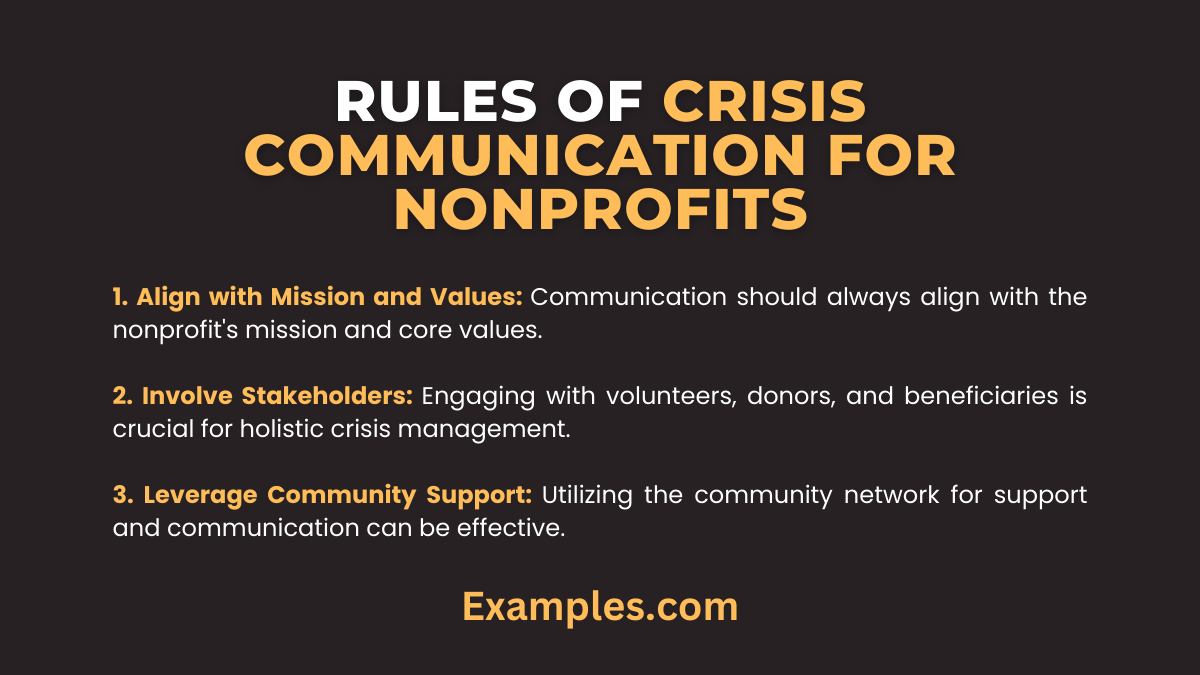
- Align with Mission and Values: Communication should always align with the nonprofit’s mission and core values.
- Involve Stakeholders: Engaging with volunteers, donors, and beneficiaries is crucial for holistic crisis management.
- Leverage Community Support: Utilizing the community network for support and communication can be effective.
- Be Resourceful with Limited Resources: Nonprofits must be creative in using available resources for maximum impact.
- Document and Learn: Documenting the crisis response and learning from it is vital for future preparedness.
In conclusion, mastering Crisis Communication Rules is essential for any organization aiming to navigate through uncertainties effectively. This guide offers comprehensive insights and practical examples, equipping professionals with the tools and strategies needed for successful crisis management. Embracing these rules can significantly enhance an organization’s ability to maintain trust, stability, and resilience during challenging times, ultimately safeguarding its reputation and stakeholder relationships.
14+ Crisis Communication Rules
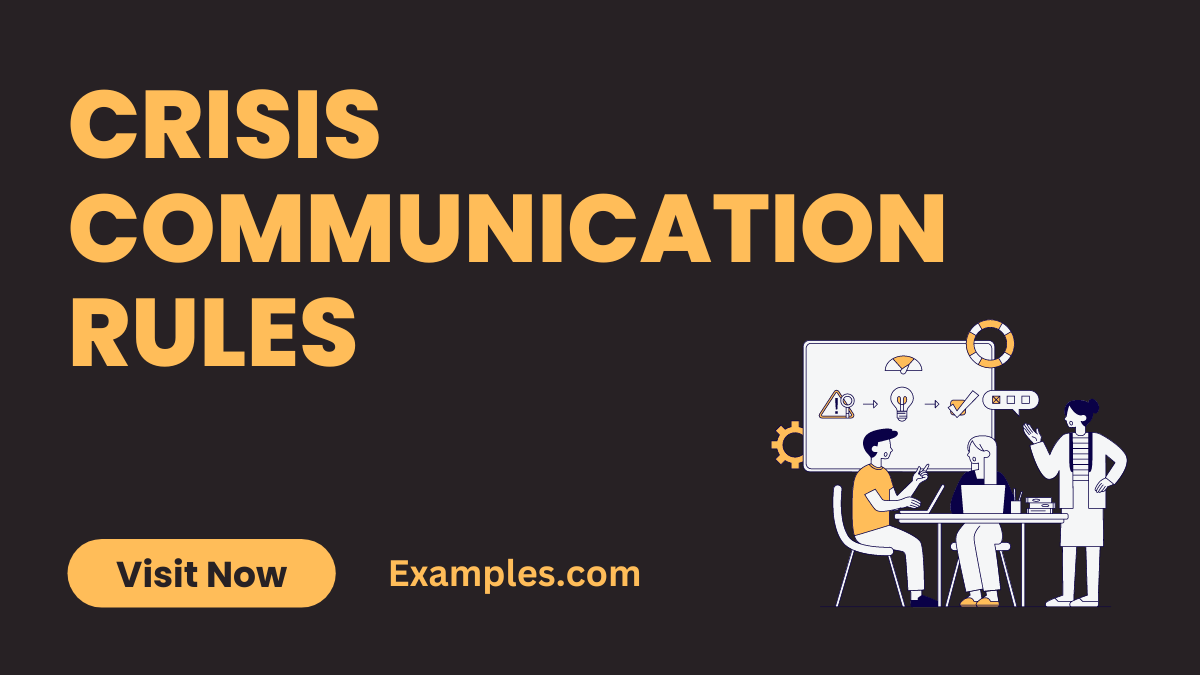
In the high-stakes world of crisis management, understanding and applying Crisis Communication Rules is crucial. This guide offers an in-depth exploration of these rules, providing readers with the essential knowledge to effectively handle crisis situations. Whether it’s a natural disaster, corporate scandal, or public health emergency, the right communication strategy can significantly alter outcomes. We delve into practical examples and expert insights, ensuring you’re equipped with effective communication tools and techniques to manage any crisis confidently.
What are Crisis Communication Rules?

Crisis Communication Rules are a set of guidelines and principles designed to guide organizations and individuals in effectively communicating during crisis situations. These rules encompass strategies for timely, transparent, and truthful information dissemination. They focus on maintaining public trust, minimizing misinformation, and facilitating efficient crisis resolution. Understanding these rules is essential for any crisis management professional, as they dictate how to communicate under pressure, coordinate with different stakeholders, and manage public relations to mitigate the impact of the crisis.
What is the Best Example of Crisis Communication Rules?

A prime example of Crisis Communication Rules in action is the proactive and transparent communication strategy employed during public health crises, like pandemics. In such scenarios, the rules emphasize the importance of providing accurate, up-to-date information to the public, addressing concerns empathetically, and correcting misinformation swiftly. Key aspects include using clear, understandable language, regularly updating stakeholders, and ensuring that all communications are coordinated across various channels. This approach helps in maintaining public trust and cooperation during critical times.
15 Crisis Communication Rules Examples

In the realm of crisis management, effective communication is key. This guide outlines 15 Crisis Communication Rules examples, each vital for navigating through turbulent times. These rules blend effective communication strategies with crisis response principles, ensuring clear, accurate, and timely information dissemination. From maintaining transparency to addressing misinformation, these rules are designed to uphold public trust and facilitate efficient crisis resolution. They are crucial for any organization aiming to handle crisis situations adeptly, preserving their reputation and stakeholder relationships.
Be Transparent and Honest
Emphasize honesty to maintain trust and credibility.
Example: “We are committed to sharing all relevant information as it becomes available.”
Communicate with Empathy
Show understanding and concern for those affected.
Example: “We understand your concerns and are here to support you.”
Respond Promptly
Quick response prevents misinformation and speculation.
Example: “We are aware of the situation and are actively working on a solution.”
Keep Messages Clear and Concise
Avoid confusion with straightforward communication.
Example: “For your safety, please follow these clear guidelines…”
Consistency Across All Channels
Ensure uniform messaging across all communication platforms.
Example: “Our statement on the matter remains the same across all our platforms.”
Regular Updates
Keep stakeholders informed with ongoing communication.
Example: “We will continue to provide updates every hour.”
Avoid Speculation
Stick to verified facts to maintain credibility.
Example: “We will share more information once it’s confirmed and verified.”
Tailor Communication to the Audience
Modify messaging to suit different stakeholder groups.
Example: “For our employees, here are the specific steps we’re taking…”
Coordinate with Relevant Authorities
Work in tandem with authorities for unified messaging.
Example: “We are in close coordination with local authorities to address this issue.”
Prepare Holding Statements
Have initial responses ready for immediate release.
Example: “We are currently gathering more information and will share details shortly.”
Monitor and Address Misinformation
Actively correct false information.
Example: “To clarify, the information circulating about X is not accurate. Here are the facts…”
Show Leadership and Responsibility
Leaders should be visible and accountable.
Example: “As CEO, I take full responsibility and am committed to resolving this.”
Use Appropriate Channels for Different Messages
Select communication mediums wisely based on the message.
Example: “For detailed updates, please refer to our official website.”
Train Staff for Crisis Communication
Equip team members with crisis communication skills.
Example: “Our staff has been trained to handle inquiries and provide accurate information.”
Review and Adapt Strategies Post-Crisis
Analyze and improve communication strategies after a crisis.
Example: “We will review our response and make necessary improvements for the future.”
Rules of Crisis Communication Examples for a Company
Effective crisis communication within a company is critical for managing any emergency situation. These rules are designed to ensure companies communicate efficiently, maintaining trust and stability. Covering aspects like internal communication, leadership involvement, and stakeholder engagement, these guidelines help in navigating complex crises. They emphasize the need for clear communication, rapid response, and consistent messaging, vital for preserving a company’s reputation and ensuring employee and customer confidence during challenging times.
Prioritize Employee Communication
Ensure employees are informed before the public to maintain internal trust.
Example: “We want our team to hear this from us first: [Crisis details]…”
Designate a Spokesperson
Appoint a trained spokesperson to provide a unified voice.
Example: “Our official spokesperson will be providing all updates regarding the situation.”
Develop a Crisis Communication Plan
Have a pre-established plan to guide crisis response.
Example: “Our crisis communication plan is activated to address the current situation.”
Conduct Regular Crisis Simulations
Regular drills to ensure readiness and identify gaps.
Example: “We will be conducting a crisis simulation exercise to test our preparedness.”
Establish a Crisis Communication Team
A dedicated team to handle crisis communications.
Example: “Our crisis communication team is working around the clock to manage this issue.”
What are the Golden Rules of Crisis Communication?
In the realm of crisis communication, certain golden rules stand as the backbone for effective management. These principles are vital for maintaining credibility and trust during challenging times.
Transparency is Key: Being open and transparent helps in maintaining trust. Concealing or manipulating information can lead to loss of credibility.
Timeliness Matters: Quick response is essential. Delay in communication can lead to speculation and misinformation.
Accuracy is Non-Negotiable: Providing accurate and verified information is crucial to maintain trust and authority.
Consistency Across Platforms: Consistent messaging across all communication channels ensures a unified voice and message.
Empathy and Understanding: Showing empathy and understanding towards those affected can help in maintaining a positive relationship with the public.
Prepare and Train: Regular training and preparation ensure that when a crisis hits, the team is ready to handle it effectively.
Crisis Communication Rules in Social Media
Act Quickly: Social media is real-time; delays can escalate the crisis.
Monitor Conversations: Keeping an eye on what’s being said helps in addressing issues and correcting misinformation quickly.
Engage Don’t Just Broadcast: Engagement with the audience is key; it’s not just about pushing out messages.
Use Visuals Wisely: Visuals can be powerful in conveying messages quickly and clearly, but they must be chosen carefully.
Have a Social Media Crisis Plan: A specific plan for social media crises helps in quick and effective management.
Being an Effective Communicator in a Crisis Rules
Stay Calm and Focused: Maintaining composure is key to clear thinking and effective communication.
Listen Actively: Understanding concerns and questions from stakeholders is crucial for effective response.
Communicate with Clarity and Simplicity: Messages should be clear and easy to understand, avoiding jargon.
Be Accessible: Availability for questions and updates is important to maintain trust and credibility.
Follow-Up Regularly: Continuous updates and follow-up communication are essential to keep everyone informed about the evolving situation.
Rules of Crisis Communication for Nonprofits

Align with Mission and Values: Communication should always align with the nonprofit’s mission and core values.
Involve Stakeholders: Engaging with volunteers, donors, and beneficiaries is crucial for holistic crisis management.
Leverage Community Support: Utilizing the community network for support and communication can be effective.
Be Resourceful with Limited Resources: Nonprofits must be creative in using available resources for maximum impact.
Document and Learn: Documenting the crisis response and learning from it is vital for future preparedness.
In conclusion, mastering Crisis Communication Rules is essential for any organization aiming to navigate through uncertainties effectively. This guide offers comprehensive insights and practical examples, equipping professionals with the tools and strategies needed for successful crisis management. Embracing these rules can significantly enhance an organization’s ability to maintain trust, stability, and resilience during challenging times, ultimately safeguarding its reputation and stakeholder relationships.


